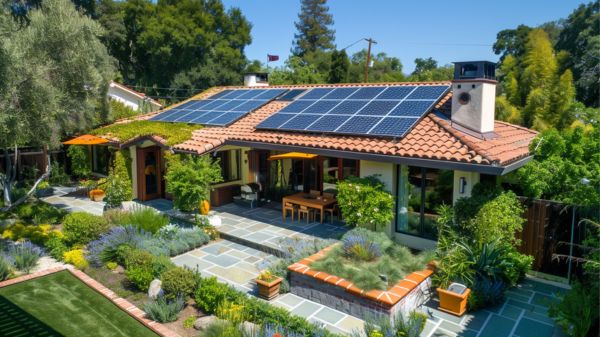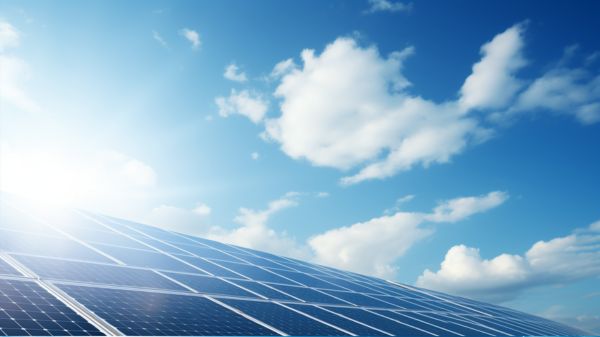The landscape of solar energy is witnessing transformative innovations that hold promising prospects for both efficiency and environmental sustainability. In this article, we’ll be discussing the latest advancements in solar panel efficiency that you should know.
Among these, the emergence of perovskite solar cells stands out, with laboratory efficiencies that now surpass traditional silicon counterparts. Additionally, bifacial technology and transparent solar panels are being integrated into urban and architectural designs, offering new avenues for energy capture without compromising aesthetics.
As we explore these advancements, one must also consider the broader implications of these technologies on global energy policies and economic frameworks. How these innovations will reshape the future of renewable energy remains an unfolding question, inviting further exploration and discussion.
Key Takeaways
- Perovskite solar cells now exceed 33% efficiency in labs, setting new benchmarks for solar technology.
- Bifacial solar panels can boost energy generation by 20-30% using reflected sunlight.
- Transparent solar panels offer over 70% transparency, ideal for integration into urban architecture.
- Floating solar farms utilize water bodies to increase efficiency and reduce land conflicts.
- Smart solar systems integrate IoT to optimize energy use and enhance grid stability.
Revolutionary Perovskite Solar Cells
Amid the evolving landscape of solar technology, perovskite solar cells have emerged as a revolutionary advancement, demonstrating laboratory efficiencies that exceed 33%. These cells, leveraging materials that offer exceptional sunlight absorption properties, greatly surpass the efficiency of traditional silicon solar cells, which generally peak below 30%.
Particularly remarkable is the tandem configuration of perovskite cells combined with silicon, which optimizes the absorption of diverse light wavelengths, thereby enhancing overall electricity production and reducing costs. This method aligns well with ongoing technological advancements that continue to push the boundaries of photovoltaic efficiency, potentially revolutionizing how solar energy is harnessed.
This innovative tandem approach has been instrumental in achieving commercial-sized perovskite cells with efficiencies up to 28.6%, as reported by industry leaders like Oxford PV. Such achievements underscore the potential for perovskite technology to transform the solar energy landscape, promising a future of more efficient and potentially liberating energy solutions.
However, the journey towards widespread commercial availability faces challenges, especially concerning durability and environmental stability. Perovskite materials are particularly sensitive to moisture and heat, which compromises their long-term performance.
Addressing these vulnerabilities is pivotal, with ongoing research aimed at enhancing the stability of these materials. Anticipated breakthroughs in this area could make perovskite solar cells a mainstay in sustainable energy production within the next 3 to 5 years.
Advancements in Bifacial Technology
The solar industry’s capacity for innovation continues to advance with developments in bifacial technology, which allows panels to capture sunlight from both sides. This advancement not only enhances the efficiency of solar panels but also greatly boosts energy generation.
By leveraging both direct and reflected sunlight, bifacial solar panel technology outpaces traditional solar panels, providing a substantial increase in energy yields. Enhanced with sun-tracking technology, these panels adapt to the sun’s movement throughout the day, ensuring maximum energy capture and markedly improving overall system productivity.
Key Enhancements in Bifacial Technology:
- Increased Energy Generation: Bifacial panels can increase energy generation by 20-30% more than traditional panels by utilizing reflected sunlight, essential in environments like snowy areas where such light is abundant.
- Improved System Efficiency: With efficiency rates exceeding 25%, bifacial technology optimizes system efficiency. This helps in reducing the levelized cost of electricity (LCOE), making solar energy a more competitive option within the energy market.
- Boost in ROI for Large-Scale Projects: The adoption of bifacial technology in large-scale solar projects has been shown to increase energy yields by up to 40% more than anticipated, thereby enhancing the financial returns on investments in renewable energy infrastructure.
These advancements underscore the vital role of bifacial technology in shaping the future of solar energy, making it increasingly viable and economically attractive for widespread implementation.
Emerging Transparent Solar Panels
Building on the momentum of innovative solar technologies like bifacial panels, the industry is also making notable strides with transparent solar panels.
These panels employ photovoltaic glaze technology, enabling them to blend seamlessly into the architectural fabric of urban environments. Unlike traditional opaque solar solutions, transparent solar panels maintain high levels of visibility—over 70% transparency—thanks to advancements by companies like Ubiquitous Energy.
In addition to their architectural integration, transparent solar panels contribute considerably to sustainable urban development by reducing greenhouse gas emissions, a key advantage emphasized in the exploration of renewable energy sources. This feature is essential for integration into the vast expanses of glass surfaces prevalent in modern cities, estimated to be between 5-7 billion square meters in the U.S. alone.
Transparent solar panels are central to the concept of building-integrated photovoltaics (BIPV), which enhances energy generation while preserving aesthetic values of buildings. This integration supports energy independence in densely populated areas, alleviating the heavy reliance on conventional power sources.
As the technology matures, substantial research is directed towards amplifying the efficiency of these panels and reducing production costs, thereby bolstering their adoption. The dual promise of aesthetic and functional energy generation positions transparent solar panels as a pivotal innovation in solar energy production, reshaping how urban spaces produce and consume energy.
Smart Solar Systems Integration
Smart solar systems are revolutionizing energy management by harnessing cutting-edge Internet of Things (IoT) technology to optimize solar energy generation and consumption.
These systems blend advanced analytics and real-time control to improve both energy efficiency and user autonomy, presenting a significant shift in how solar power is utilized and managed.
Key features of smart solar systems include:
- Predictive Analytics: Using AI, these systems analyze weather data and consumption patterns to predict solar energy generation and demand. This allows for proactive adjustments to maximize efficiency and guarantee uninterrupted power supply.
- Energy Management Systems: Integrated systems automatically manage the distribution of solar power. They can direct energy to where it’s needed most, whether it’s charging electric vehicles, powering appliances, or storing excess energy in battery systems for later use.
- Smart Grid Compatibility: These solar systems communicate with the larger electrical grid to offer demand response services. This interaction helps balance the grid during peak times, reducing the need for traditional energy sources and enhancing overall grid stability.
With the integration of smart grids, these systems not only manage solar power more efficiently but also support the broader grid’s needs through enhanced communication and interoperable technology.
As the market for smart solar technologies grows, these innovations offer promising advances in energy management, operational efficiencies, and sustainable energy liberation.
Innovative Floating Solar Farms
Why limit solar panel installations to land when water bodies offer untapped potential? Floating solar farms, or floatovoltaics, represent a cutting-edge development in solar technology, harnessing water surfaces to address the dual challenges of energy production and environmental sustainability.
By deploying floating solar panels on just 10% of hydropower reservoirs, it’s possible to match the energy output traditionally associated with fossil fuels, presenting a compelling case for widespread adoption in the global market.
These aquatic solar installations benefit from a natural cooling effect provided by water, greatly enhancing the efficiency of the solar panels. This not only boosts energy production but also extends the lifespan of the panels, optimizing renewable energy investments.
Furthermore, floating solar farms contribute to environmental sustainability by reducing water evaporation and curbing algae growth, thereby improving water quality. Additionally, as highlighted in recent technological advancements, the integration of smart grid technologies with off-grid systems like floatovoltaics is paving the way for more resilient and adaptable renewable energy infrastructures.
Internationally, projects like the Heroldsberg Solar Farm in California and the Dezhou Floating Solar Farm in China underscore the growing implementation of this innovative technology.
As the global market for floating solar expands, these installations play a pivotal role in the shift towards a more liberated, renewable energy-driven world, showcasing the synergy between technological advancement and ecological harmony.
Conclusion
To conclude, the landscape of solar technology has transformed through the development of perovskite solar cells, bifacial technology, transparent solar panels, smart solar systems, and floating solar farms. These innovations not only mark significant strides in efficiency and utility but also enhance the sustainability of solar energy solutions.
The integration of advanced materials, intelligent technology, and strategic installations exemplifies a forward-thinking approach to addressing global energy needs while minimizing environmental impacts. This evolution is pivotal for the future of renewable energy technologies.




